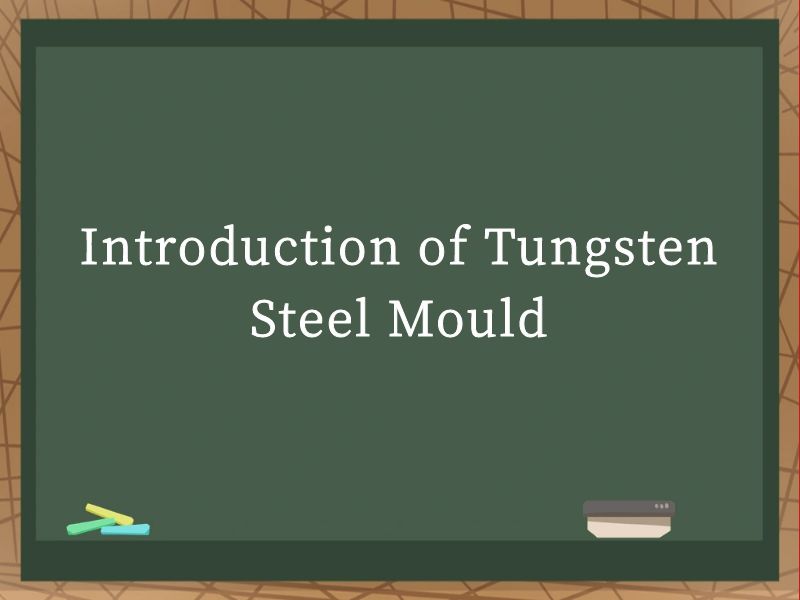JOURNALISM
- NEWS -
|
Introduction of Tungsten Steel MouldIntroduction of Tungsten Steel Mould.Tungsten steel moulds, also known as carbide moulds, represent a significant technological advancement in the manufacturing industry. These moulds are renowned for their exceptional hardness, wear resistance, and ability to maintain precision over extended periods of use. In this detailed exploration, we will delve into the composition, manufacturing processes, applications, advantages, limitations, and future prospects of tungsten steel moulds. Our discussion aims to provide a comprehensive understanding of this crucial tool in modern manufacturing.
Composition and Properties Tungsten steel, or tungsten carbide (WC), is a composite material primarily composed of tungsten and carbon. The stoichiometric formula WC denotes an equal atomic ratio of tungsten and carbon, forming a hard, crystalline structure. This material's hardness surpasses that of most metals, rivaling even diamond in certain aspects while maintaining superior toughness and machinability. The hardness of tungsten carbide arises from its covalent bonding structure, where tungsten atoms are surrounded by carbon atoms in a tetrahedral arrangement. This arrangement provides a robust lattice that is resistant to deformation and wear. Additionally, tungsten carbide exhibits high thermal stability, allowing it to retain its hardness and strength at elevated temperatures. To enhance its machinability and toughness, tungsten carbide is often combined with a metallic binder, such as cobalt (Co), nickel (Ni), or iron (Fe). The binder acts as a ductile phase that facilitates the sintering process and improves the material's shock resistance. The proportion of binder in the composite can be adjusted to tailor the mould's properties for specific applications. For instance, a higher cobalt content enhances toughness at the cost of some hardness. Manufacturing Processes The production of tungsten steel moulds involves several intricate steps, each critical to ensuring the final product's quality and performance. Powder Preparation: The raw materials—tungsten powder, carbon powder, and binder metal powder—are meticulously mixed in precise proportions. The particle size and distribution of these powders play a crucial role in determining the sintered mould's microstructure and properties. The mixture is then milled to ensure homogeneous blending. Compaction: The mixed powder is pressed into the desired mould shape using either isostatic or uniaxial pressing techniques. Isostatic pressing applies uniform pressure to the powder, promoting better densification and fewer defects. The pressed compact is then dewaxed to remove any binders or lubricants used during compaction. Sintering: The dewaxed compact undergoes sintering, a high-temperature process that consolidates the powder particles into a dense, solid structure. Sintering is typically carried out in a controlled atmosphere to prevent oxidation and achieve optimal microstructure development. The sintering temperature and duration depend on the composition and desired properties of the mould. Finishing: After sintering, the mould undergoes various finishing operations, including grinding, polishing, and sometimes coating. These steps are essential for achieving the required dimensional accuracy, surface finish, and enhancing wear resistance. Coatings, such as titanium nitride (TiN) or chromium nitride (CrN), can further improve the mould's performance in specific applications. Applications Tungsten steel moulds find extensive applications across various industries due to their exceptional properties. Plastic Injection Moulding: In the plastics industry, tungsten steel moulds are used to produce high-precision parts with intricate designs. Their hardness and wear resistance ensure long-term dimensional stability and minimal maintenance. Die Casting: For die-casting metals such as aluminum, zinc, and magnesium, tungsten steel moulds provide the necessary durability and thermal shock resistance. They withstand the high pressures and temperatures involved in the die-casting process, ensuring consistent part quality. Extrusion Moulding: In extrusion processes, tungsten steel dies are employed to shape materials like ceramics, metals, and plastics into continuous profiles. Their ability to maintain precise dimensions and resist wear makes them ideal for high-volume production. Powder Metallurgy: Tungsten steel moulds are also used in powder metallurgy for compacting metal powders into shaped components. Their hardness and wear resistance ensure consistent product quality and minimal tool wear. Other Applications: Beyond these primary applications, tungsten steel moulds are also used in industries such as rubber molding, glass forming, and electronic packaging. Their versatility makes them a valuable asset in a wide range of manufacturing processes. Advantages The adoption of tungsten steel moulds offers numerous advantages over traditional materials, including: High Hardness and Wear Resistance: Tungsten carbide's hardness is several times greater than that of conventional steel, significantly extending the mould's service life and reducing the frequency of tool replacement. Dimensional Stability: Due to their low coefficient of thermal expansion, tungsten steel moulds maintain precise dimensions even under high-temperature conditions, ensuring consistent part quality. Thermal Resistance: These moulds can withstand high temperatures without significant softening or deformation, making them suitable for applications involving thermal cycling. Corrosion Resistance: Tungsten carbide is highly resistant to chemical attack, ensuring that the mould remains unaffected by the materials being processed. Longevity and Cost-Effectiveness: Despite their initial higher cost, tungsten steel moulds offer a lower overall cost per part due to their extended service life and reduced maintenance requirements. Limitations While tungsten steel moulds offer numerous benefits, they do have some limitations that should be considered: Brittle Nature: Tungsten carbide is relatively brittle and susceptible to chipping or cracking under impact loads. This limits their use in applications involving high mechanical stress. Machining Difficulty: Due to their hardness, tungsten steel moulds are challenging to machine, requiring specialized tools and techniques. This can increase manufacturing costs and lead to longer lead times. Sensitivity to Thermal Shock: Although resistant to high temperatures, tungsten carbide can suffer from thermal shock cracking if subjected to rapid temperature changes. Care must be taken to manage thermal gradients during use. Cost: The raw materials and manufacturing processes involved in producing tungsten steel moulds are more expensive than those for traditional materials, making them less suitable for low-volume or prototype production. Future Prospects The future of tungsten steel moulds looks promising, driven by ongoing advancements in material science and manufacturing technology. Researchers are continuously exploring new binder systems and sintering techniques to improve the material's toughness, machinability, and cost-effectiveness. Advancements in coating technologies, such as nanocoatings and ceramic coatings, offer the potential to further enhance the wear resistance and corrosion resistance of tungsten steel moulds. These coatings can be tailored to specific applications, providing additional protection against harsh environments and extending the mould's service life. In addition, the increasing adoption of automation and advanced manufacturing techniques, such as additive manufacturing (3D printing), is likely to revolutionize the production of tungsten steel moulds. These technologies enable the creation of complex geometries and customized solutions that were previously unattainable. Moreover, as sustainability becomes a growing concern, the development of tungsten steel moulds with reduced environmental impact is gaining attention. Efforts are being made to optimize material usage, minimize waste, and develop recycling processes for worn-out moulds. Conclusion in a Different Form Reflecting on the intricate world of tungsten steel moulds, we see a material and technology that has significantly transformed manufacturing processes. Its unparalleled hardness, wear resistance, and dimensional stability have made it a staple in industries requiring precision and durability. Despite some limitations, ongoing research and technological advancements are poised to overcome these challenges, pushing the boundaries of what is possible with tungsten steel moulds. As we stand on the cusp of a new era in manufacturing, the role of tungsten steel moulds will continue to evolve, adapting to the demands of a rapidly changing world. Their ability to withstand harsh conditions, maintain precision, and deliver consistent quality makes them a cornerstone of modern industrial production. With continuous innovation and a commitment to sustainability, the future of tungsten steel moulds is set to shine brightly. |


